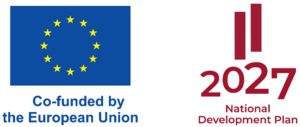
Identification number: 1.1.1.3/1/24/A/021
Type: European Regional Development Fund (ERDF)
Duration: 01.07.2025. - 30.06.2028.
Project Leader: Ph.D. Ainārs Ozols, Institute of Solid State Physics University of Latvia (ISSP UL)
Responsible person from ISSP UL: Ph.D. Ainārs Ozols, ISSP UL
Project partners: Macro Innovation Ltd
Total funding: 683 000 EUR
ERDF funding: 466 200 EUR
Aim:
The main scientific and engineering goal of the proposed project is to develop thinner, high quality, and parameter-consistent multi-layer liquid crystal display modules (m-LCD) that are also environmentally friendly. These modules are needed for applications in miniature multi focal image rendering for virtual and augmented reality near-to-eye displays and variable focus vision correction glasses. Typically, these multi-layer liquid crystal elements are formed by adhering individual display elements, such as liquid crystal cells, together. Proposed solution is to create these multilayer modules by constructing them in stages, layer by layer sharing one glass for two elements. This approach would reduce the distance between the LC layers and eliminate the need for environmentally harmful acids used in glass etching.
Summary:
The main scientific and engineering goal of the non-commercial industrial research project application is to achieve the production of thinner and more environmentally friendly liquid crystal multi-layer modules, which can be applied to both miniature multi-focal image rendering applications in virtual and augmented reality near-to-eye displays and variable focus vision correction glasses as well as other multi-layer liquid crystal devices. During the 36-month period two partners, Institute of Solid State Physics, University of Latvia and private entity Macro Innovation, will develop a new method to fabricate multiple layer LC-modules without using optical adhesives and a bonding process of individual cells, and research on application of hyperspectral imaging method for fast liquid crystal layer thickness mapping. Modules will be tested in extended reality near-to eye display for optical image aberrations and user experience.
Expected scientific results:
Activities will provide an LCD prototype as a corresponding result and lead to submission of patent applications and two open access publications.
Tasks at ISSP UL:
Research of new LCD module fabrication method.
Research and development of hyperspectra imaging method for cell gap thickness mapping.
PROJECT PROGRESS
18.12.2025.
The components of the hyperspectral system have been assembled into a single system, and a working prototype has been created (see image). Image processing algorithms have been developed.
The production process of liquid crystal devices has been initiated.
The partner continues work on modeling the multilayer device.

30.09.2025.
Procurement of hyperspectral system components and their assembly into a single system has been carried out.
Development of image processing algorithms has begun.The necessary components for the creation of liquid crystal devices have been ordered, and the manufacturing process has started.
The partner has begun modeling the multilayer device.